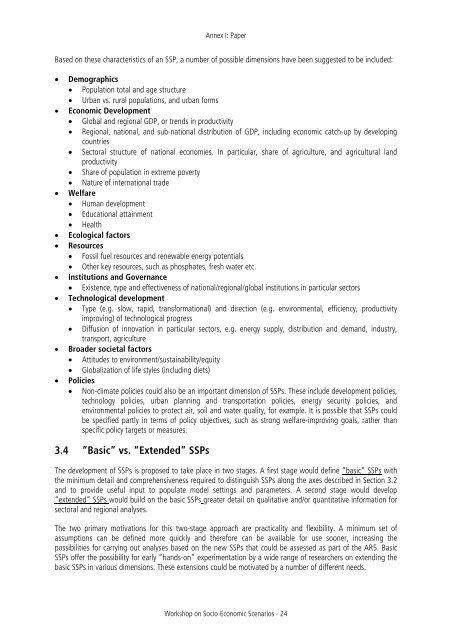Workshop Report - IPCC
Workshop Report - IPCC
Workshop Report - IPCC
Create successful ePaper yourself
Turn your PDF publications into a flip-book with our unique Google optimized e-Paper software.
Annex I: Paper<br />
Based on these characteristics of an SSP, a number of possible dimensions have been suggested to be included:<br />
<br />
<br />
<br />
<br />
<br />
<br />
<br />
<br />
<br />
Demographics<br />
Population total and age structure<br />
Urban vs. rural populations, and urban forms<br />
Economic Development<br />
Global and regional GDP, or trends in productivity<br />
Regional, national, and sub-national distribution of GDP, including economic catch-up by developing<br />
countries<br />
Sectoral structure of national economies. In particular, share of agriculture, and agricultural land<br />
productivity<br />
Share of population in extreme poverty<br />
Nature of international trade<br />
Welfare<br />
Human development<br />
Educational attainment<br />
Health<br />
Ecological factors<br />
Resources<br />
Fossil fuel resources and renewable energy potentials<br />
Other key resources, such as phosphates, fresh water etc.<br />
Institutions and Governance<br />
Existence, type and effectiveness of national/regional/global institutions in particular sectors<br />
Technological development<br />
Type (e.g. slow, rapid, transformational) and direction (e.g. environmental, efficiency, productivity<br />
improving) of technological progress<br />
Diffusion of innovation in particular sectors, e.g. energy supply, distribution and demand, industry,<br />
transport, agriculture<br />
Broader societal factors<br />
Attitudes to environment/sustainability/equity<br />
Globalization of life styles (including diets)<br />
Policies<br />
Non-climate policies could also be an important dimension of SSPs. These include development policies,<br />
technology policies, urban planning and transportation policies, energy security policies, and<br />
environmental policies to protect air, soil and water quality, for example. It is possible that SSPs could<br />
be specified partly in terms of policy objectives, such as strong welfare-improving goals, rather than<br />
specific policy targets or measures.<br />
3.4 “Basic” vs. “Extended” SSPs<br />
The development of SSPs is proposed to take place in two stages. A first stage would define “basic” SSPs with<br />
the minimum detail and comprehensiveness required to distinguish SSPs along the axes described in Section 3.2<br />
and to provide useful input to populate model settings and parameters. A second stage would develop<br />
“extended” SSPs would build on the basic SSPs greater detail on qualitative and/or quantitative information for<br />
sectoral and regional analyses.<br />
The two primary motivations for this two-stage approach are practicality and flexibility. A minimum set of<br />
assumptions can be defined more quickly and therefore can be available for use sooner, increasing the<br />
possibilities for carrying out analyses based on the new SSPs that could be assessed as part of the AR5. Basic<br />
SSPs offer the possibility for early “hands-on” experimentation by a wide range of researchers on extending the<br />
basic SSPs in various dimensions. These extensions could be motivated by a number of different needs.<br />
<strong>Workshop</strong> on Socio-Economic Scenarios - 24

















